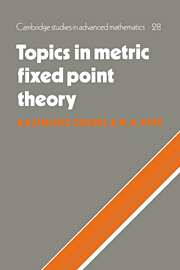Book contents
- Frontmatter
- Contents
- Preface
- 1 Preliminaries
- 2 Banach's Contraction Principle
- 3 Nonexpansive mappings: introduction
- 4 The basic fixed point theorems for nonexpansive mappings
- 5 Scaling the convexity of the unit ball
- 6 The modulus of convexity and normal structure
- 7 Normal structure and smoothness
- 8 Conditions involving compactness
- 9 Sequential approximation techniques for nonexpansive mappings
- 10 Weak sequential approximations
- 11 Properties of fixed point sets and minimal sets
- 12 Special properties of Hilbert space
- 13 Applications to accretivity
- 14 Ultrafilter methods
- 15 Set-valued mappings
- 16 Uniformly lipschitzian mappings
- 17 Rotative mappings
- 18 The theorems of Brouwer and Schauder
- 19 Lipschitzian mappings
- 20 Minimal displacement
- 21 The retraction problem
- Appendix: notes and comments
- References
- Index
18 - The theorems of Brouwer and Schauder
Published online by Cambridge University Press: 21 October 2009
- Frontmatter
- Contents
- Preface
- 1 Preliminaries
- 2 Banach's Contraction Principle
- 3 Nonexpansive mappings: introduction
- 4 The basic fixed point theorems for nonexpansive mappings
- 5 Scaling the convexity of the unit ball
- 6 The modulus of convexity and normal structure
- 7 Normal structure and smoothness
- 8 Conditions involving compactness
- 9 Sequential approximation techniques for nonexpansive mappings
- 10 Weak sequential approximations
- 11 Properties of fixed point sets and minimal sets
- 12 Special properties of Hilbert space
- 13 Applications to accretivity
- 14 Ultrafilter methods
- 15 Set-valued mappings
- 16 Uniformly lipschitzian mappings
- 17 Rotative mappings
- 18 The theorems of Brouwer and Schauder
- 19 Lipschitzian mappings
- 20 Minimal displacement
- 21 The retraction problem
- Appendix: notes and comments
- References
- Index
Summary
We have been using the term ‘fixed point property’ (f.p.p.) as it relates to the class of nonexpansive mappings but, of course, this property may be applied to any class of mappings. The ‘topological’ fixed point property is of fundamental importance in the broader context of fixed point theory.
Definition 18.1 A topological space X is said to have the (topological) fixed point property (t.f.p.p. or f.p.p. if the meaning is clear) if each continuous mapping T: X→X has a fixed point.
It is not surprising that the above property is a topological invariant.
Lemma 18.1 If X and Y are homeomorphic and if X has the t.f.p.p., then Y also has the t.f.p.p.
Proof Let h: X→Y be a homeomorphism with h(X) = Y, and suppose f: Y→Y is continuous. Then g = h–1 ∘ f ∘ h: X→X and g is continuous; hence there exists x ∈ X such that gx = x, implying y = hx = fy.
Another very useful observation about the t.f.p.p. is the following:
Lemma 18.2 If a topological space X has the t.f.p.p. and if Y is a retract of X, then Y has the t.f.p.p.
Proof. Let r be a retraction of X onto Y and let f: Y→Y be continuous. Then f may be extended to a continuous mapping g = f ∘ r: X→X. Any fixed point of g must also be a fixed point of f.
- Type
- Chapter
- Information
- Topics in Metric Fixed Point Theory , pp. 187 - 201Publisher: Cambridge University PressPrint publication year: 1990

